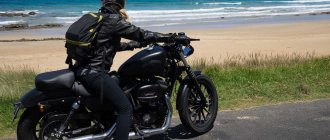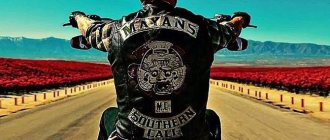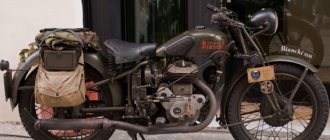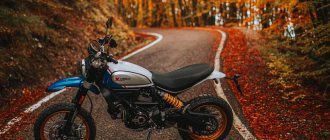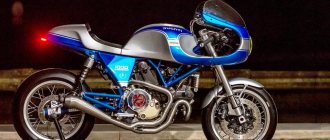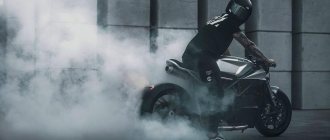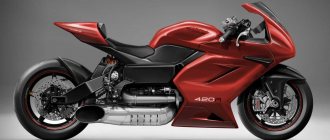If there is a motorcycle brand in Europe that almost everyone knows, it is Ducati. These are the motorcycles that have made many riders champions. They performed at many of the most prestigious world and European championships.
Against the backdrop of the ever-leading Germany, Italian manufacturers usually felt secondary. With the era of Japanese dominance, problems arose among the Germans themselves, who, although they created the world's first motorcycle, were unable to retain the palm.
Among all modern European brands, only BMW (+Husqvarna), Aprillia and Ducati were able to oppose something to Japanese technology. But this happened in relatively recent times.
Radio engineering beginning
The Ducati company was founded in 1926 in Bologna. The founders of the company were brothers Adriano and Marcello Ducati. Both of them were interested in radio engineering, so the first direction of the company’s work was the production of radio equipment. In the 20s of the 20th century, the demand for horns and loudspeakers did its job, and the company developed well.
After World War II, the demand for radio equipment fell sharply, and the company came under state control. At that time, the creation of cheap means of transportation was important for Italy, so Ducati's activities were retrained to produce vehicles.
Ducati motorcycles
Ducati is a famous Italian manufacturer of sportbikes and all-terrain motorcycles with an L-shaped engine. The company was founded in 1926 in Bologna. At first, Ducati produced radio equipment, but the factories were destroyed during the Second World War and after it the company began producing engines for motorcycles.
By the end of the 50s, the company successfully competed in motorcycle racing with the powerful Ducati 250 Twin motorcycle. A feature of most Ducati V-twin engines is that the angle between the cylinders is 90 degrees, and one of them is parallel to the ground. This served as the basis for the name of the line of engines - L-shaped.
In addition to the unusual engine, Ducati motorcycles had another feature - the “desmodromic” valve system. This design was developed by engineer Fabio Taglioni, and, largely thanks to it, the company successfully competed in sports competitions. A special feature of this system is the use of a cam drive for the valves. The industry of that time could not provide the required quality of springs for closing valves at high speeds, and the new “desmodromic” system allowed Ducati motorcycles not only to increase efficiency and engine life at high speeds, but also to increase torque at the bottom.
In the 60s and 70s, Ducati continued to compete successfully in racing, improving its sports motorcycles. It was in the 70s that L-Twin engines gained sports fame and became widespread among “civilian” motorcycles.
In 1983, Ducati was acquired by the Castiglioni family and the company merged with the Cagiva group. At this time, Ducati sportbikes continue to be improved and the first model from the Ducati Monstr line of universal motorcycles, which is still popular today, is released.
In the mid-90s, Ducati changed ownership again - the company was acquired by the Texas Pacific investment group. Ducati sports bikes actively and successfully compete in the prestigious World Superbike series.
Success in the World Superbike series pushed Ducati to participate in the MotoGP World Championship. For this purpose, a Ducati Desmosedici GP motorcycle with a V-shaped four-cylinder engine was specially released. In 2007, Ducati wins the MotoGP World Championship.
Now Ducati continues to adhere to the principle of “win a race today, sell a bike tomorrow”, spending about 10% of its budget on sports. Thanks to this spending, the company has a very strong position in sportbikes, superbikes and road bikes. The company is also actively developing enduro motorcycles and cruisers, trying to gain a foothold in new market segments.
Start of motorcycle production
The first production products were engines, designed by engineer Aldo Farinelli. As soon as Farinelli returned to designing sports cars, Ducati celebrated its rebirth. Their first velomobile was called Cucciolo (Russian puppy), and differed from existing velomobiles on the market with an engine capacity of 50 cc. see and excellent traction at low speeds.
Already in the early 1950s, Ducati conquered half of the Italian motorcycle market. By this time, light motorcycles were becoming increasingly popular. And already in 1952 the Cruiser model was released. The new motorcycle was equipped with an engine with an electric starter. With an engine capacity of 175 cc. see the motorcycle's power was 8 liters. With. The only negative was the automatic transmission, since at that time they could not evaluate it properly. But a little later, 3-speed Cucciolo with an engine capacity of 55 cc appeared on the market. see and Cruiser with a volume of 98 cc. cm. These were the first motorcycles that had a telescopic fork, a spinal frame and a rear swingarm.
A little later, Ducati decided to try their hand at sports and released the 98 Sport model. The first sports model accelerated to 95 km/h with a power of 6.5 hp. With.
How it all started
The company from Bologna was created in 1926 by the Ducati brothers - Adriano and Marcello.
The brothers' first brainchild in the field of motorcycle development is Cucciolo. This is a velomobile, still extremely far from what we call a motorcycle. However, the volume of 50 cubic meters and good speed made it popular among the population. The simple design and affordable price of models from Ducati allowed 50 to become a leader in the production of such equipment.
The first light motorcycle rolled off the assembly line of the Bologna factory in 1952. This model was called "Cruiser". It was already equipped with an electric starter and was quite modern.
Engine 175 cc, 8 liters. with, with an automatic transmission it was quite good. And soon 98 cc versions of this car appeared.
Fabio Taglioni period
And in 1954, the young engineer Fabio Taglioni became the chief designer. The main achievements of Ducati are associated with him. His first motorcycle was a Ducati 100 Gran Sport with a 98 cc engine. The riders immediately liked it. Fabio sought to increase engine power by increasing speed. By placing the camshaft in the cylinder head, the engineer was able to achieve 9 horsepower. With. and 9,000 rpm, which allowed a motorcycle weighing 80 kg to reach speeds of up to 130 km/h. The desmodromic drive with a mechanism for forced opening and closing of valves, developed by Taglioni in mid-1956, appeared on the new motorcycle model only in 1958. The single-cylinder engine of this motorcycle was 125 cc. see. And the next year Ducati released a similar motorcycle, only with a two-cylinder engine.
But this is all for sporting purposes; for the domestic market, Ducati produced motorcycles with 175 and 200 cc engines. cm. And already in the early 60s, a new generation motorcycle was created - Ducati 250 (18 hp, 4 strokes, overhead camshaft). Motorists easily increased the engine capacity of this model to 450 cc. The most efficient models with a 250 cm³ engine were the Mach 1 of 1964 and the Mark 3D of 1968.
Taglioni later began developing a 1,300 cc engine for the US government. The result was a 4-cylinder engine (100 hp) Apollo. But at that time, tires suitable for such power had not yet been created, so its use had to be abandoned. True, in the Ducati 750GT motorcycle (1970), Fabio installed a simplified version of this engine with a volume of 750 cc. cm. This model could accelerate to almost 200 km/h with a weight of 185 kg and an engine of 60 hp. A similar Super Sport 750 motorcycle with desmodromic drive accelerated to 215 km/h. These technologies made it possible to win first places in motorcycle racing year after year.
But Taglioni went further, he replaced the camshaft from bevel gears with a toothed belt, and in the manufacture of cylinders he used an aluminum alloy with a nickel-silicon coating instead of cast iron. Around this time, the famous Ducati frame made from chrome-molybdenum steel tubes, similar to a birdcage, appeared.
In 1979, Ducati released the 500 Pantah, this model was the fastest with an engine capacity of 500 cc. cm.
In the 1980s, the company experienced a crisis. In 1985, the competing and successful motorcycle concern Cagiva bought out the production of Ducati motorcycles and began producing enduro-style motorcycles based on Ducati two-cylinder engines.
Ducati motorcycle range
As soon as you hear the name Ducati, your ears immediately hear the sound characteristic of racing motorcycles. The exclusivity of the brand lies in the fact that production is aimed not at quantity, but at quality. But it was not easy for the company to gain recognition in the motorcycle world. In fact, Ducati Motor Holding SpA was forced to collect bikes by the circumstances that developed in Italy after the Second World War. Since 1926, the company specialized in the production of radio equipment, which the Ducati brothers were fond of. In the post-war years, in order to stay afloat, it was necessary to provide the dilapidated country with affordable means of transportation.
The predecessor of racing cars was the Cucciolo motorized bicycle, the engine for which was developed by Aldo Farinelli. A little later, the first full-fledged Cruiser motorcycle appeared with revolutionary new products: an automatic transmission and an electric starter. The consumer's unpreparedness for innovation has become the reason for its unpopularity.
In 1954, designer Fabio Taglioni got a job at Ducati. He developed and introduced into production motorcycles with a desmodromic drive, which made it possible to reach high speeds with little power. Now high engine speeds are not a hindrance. New alloys were invented for casting cylinders and frames. The success and celebrity of the brand is achieved on the most prestigious tracks in the world.
In the early 80s, Ducati Motor Holding SpA went into decline and was absorbed by the Cagiva concern. Thanks to this, the range of bikes is expanding and enduro bikes are appearing. Since 2012, the Ducati brand has been owned by Audi AG.
In Russia, the most racing of ordinary motorcycles can be purchased through a network of official company representatives. These are road bikes, enduro and supersport. In the line of supersport models, it is worth highlighting the Ducati 1199 Superleggera. This is a limited edition of 500 pieces. It is super lightweight due to the use of the latest raw materials: titanium, magnesium, carbon fiber. An engine with a volume of almost 1200 cm3 accelerates the bike at more than 200 km/h.
Ducati Monster road monsters of various configurations are easily recognized by their characteristic birdcage frame. These are easy to control motorcycles for riding on city streets. Each subsequent configuration is more and more advanced.
Enduro is the off-road equipment of the Hyperstrada, Multistrada and Hypermotard series. They feature spoked wheels, extended front fenders and a wide handlebar.
Massimo Bordi's period and the present time
Just in 1985, after the retirement of Fabio Taglioni, the position of chief designer was taken by Massimo Bordi. Based on Pantah engines of 350, 750 and 904 cc. see single-seat sports models Ducati 350F3 and 750F1, touring Ducati 350/750 Paso, and Ducati Super Sport were produced. From this moment on, Ducati begins its cooperation with the Italian company Termignoni, the manufacturer of exhaust systems.
The Ducati 916 debuted in the early 1990s. The design of the motorcycle was done by Italian designer Massimo Tamburini, who created the design of a number of Bimota motorcycles, as well as the MV Agusta F4 and Brutale. It had a small feature - a cantilever rear wheel suspension with a front suspension in the form of an inverted telescope fork.
In 1992, designer Michel Galuzzi created the legendary Monster model. It had a two-cylinder L-shaped engine with two-valve cylinder heads and air-oil cooling. The next step was the Ducati 748 and Ducati 916 motorcycles, their engines had Desmoquatro valve actuators, liquid cooling and fuel injection.
In 2000, the Testatretta model appeared. During its development, every part of the engine was computer processed to reduce weight and increase strength. An even more advanced engine with a capacity of 135 hp was developed in this way. With. (10200 rpm) was installed on the new Ducati 996R model.
In 2012 the company was purchased by Audi AG

